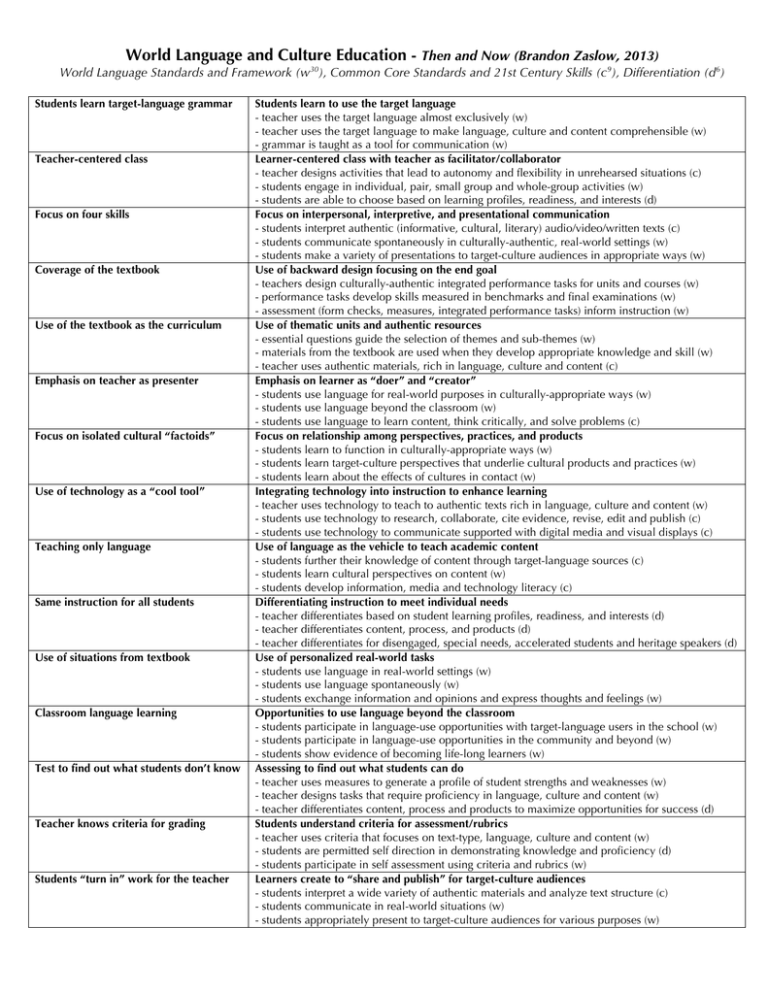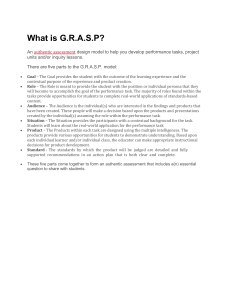WLC Education Then and Now
advertisement

World Language and Culture Education - Then and Now (Brandon Zaslow, 2013) World Language Standards and Framework (w30), Common Core Standards and 21st Century Skills (c9), Differentiation (d6) Students learn target-language grammar Teacher-centered class Focus on four skills Coverage of the textbook Use of the textbook as the curriculum Emphasis on teacher as presenter Focus on isolated cultural “factoids” Use of technology as a “cool tool” Teaching only language Same instruction for all students Use of situations from textbook Classroom language learning Test to find out what students don’t know Teacher knows criteria for grading Students “turn in” work for the teacher Students learn to use the target language - teacher uses the target language almost exclusively (w) - teacher uses the target language to make language, culture and content comprehensible (w) - grammar is taught as a tool for communication (w) Learner-centered class with teacher as facilitator/collaborator - teacher designs activities that lead to autonomy and flexibility in unrehearsed situations (c) - students engage in individual, pair, small group and whole-group activities (w) - students are able to choose based on learning profiles, readiness, and interests (d) Focus on interpersonal, interpretive, and presentational communication - students interpret authentic (informative, cultural, literary) audio/video/written texts (c) - students communicate spontaneously in culturally-authentic, real-world settings (w) - students make a variety of presentations to target-culture audiences in appropriate ways (w) Use of backward design focusing on the end goal - teachers design culturally-authentic integrated performance tasks for units and courses (w) - performance tasks develop skills measured in benchmarks and final examinations (w) - assessment (form checks, measures, integrated performance tasks) inform instruction (w) Use of thematic units and authentic resources - essential questions guide the selection of themes and sub-themes (w) - materials from the textbook are used when they develop appropriate knowledge and skill (w) - teacher uses authentic materials, rich in language, culture and content (c) Emphasis on learner as “doer” and “creator” - students use language for real-world purposes in culturally-appropriate ways (w) - students use language beyond the classroom (w) - students use language to learn content, think critically, and solve problems (c) Focus on relationship among perspectives, practices, and products - students learn to function in culturally-appropriate ways (w) - students learn target-culture perspectives that underlie cultural products and practices (w) - students learn about the effects of cultures in contact (w) Integrating technology into instruction to enhance learning - teacher uses technology to teach to authentic texts rich in language, culture and content (w) - students use technology to research, collaborate, cite evidence, revise, edit and publish (c) - students use technology to communicate supported with digital media and visual displays (c) Use of language as the vehicle to teach academic content - students further their knowledge of content through target-language sources (c) - students learn cultural perspectives on content (w) - students develop information, media and technology literacy (c) Differentiating instruction to meet individual needs - teacher differentiates based on student learning profiles, readiness, and interests (d) - teacher differentiates content, process, and products (d) - teacher differentiates for disengaged, special needs, accelerated students and heritage speakers (d) Use of personalized real-world tasks - students use language in real-world settings (w) - students use language spontaneously (w) - students exchange information and opinions and express thoughts and feelings (w) Opportunities to use language beyond the classroom - students participate in language-use opportunities with target-language users in the school (w) - students participate in language-use opportunities in the community and beyond (w) - students show evidence of becoming life-long learners (w) Assessing to find out what students can do - teacher uses measures to generate a profile of student strengths and weaknesses (w) - teacher designs tasks that require proficiency in language, culture and content (w) - teacher differentiates content, process and products to maximize opportunities for success (d) Students understand criteria for assessment/rubrics - teacher uses criteria that focuses on text-type, language, culture and content (w) - students are permitted self direction in demonstrating knowledge and proficiency (d) - students participate in self assessment using criteria and rubrics (w) Learners create to “share and publish” for target-culture audiences - students interpret a wide variety of authentic materials and analyze text structure (c) - students communicate in real-world situations (w) - students appropriately present to target-culture audiences for various purposes (w)
